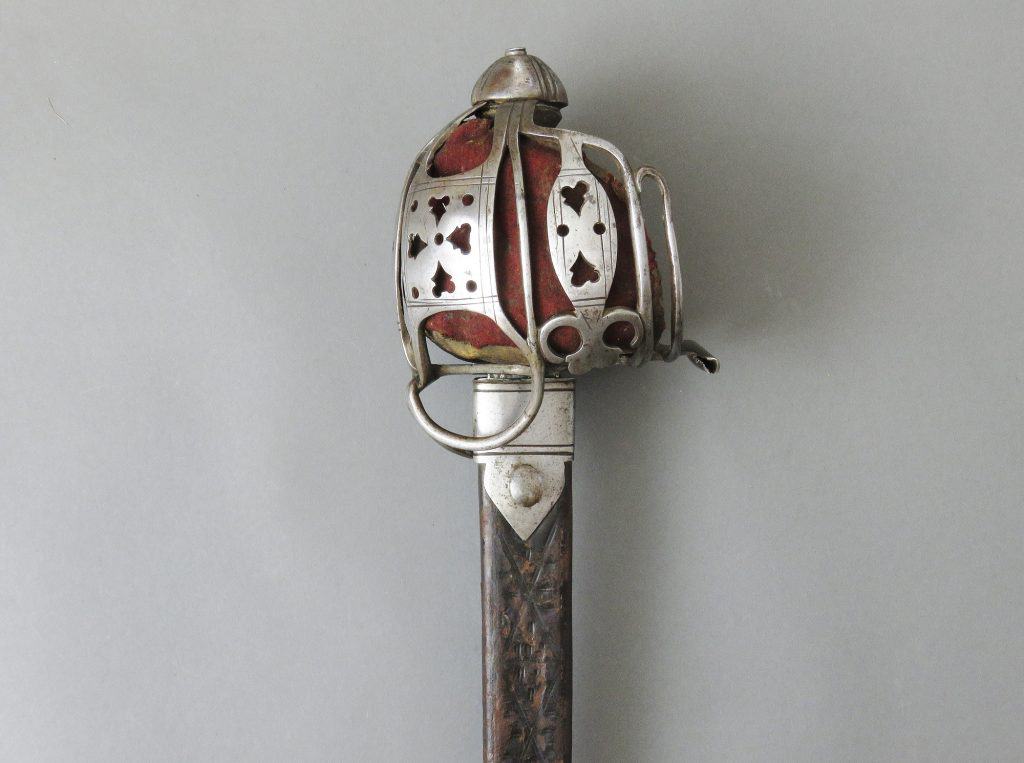
A fine Scottish Basket Hilted Sword with its Scabbard dating to circa 1730
To enquire about this itemplease click here
Price: £6,450
Ref: 52081810
Item Description
An attractive Scottish basket hilted sword dating to the period preceding the last Jacobite Rebellion which commenced in 1745 and ended with the Battle of Culloden in 1746. The sword is in fine condition and retains its scabbard.
The basket guard is finely forged from rounded structural bars resulting in an elegantly contoured hilt. The two main frontal guard panels are decorated in traditional style, with vertical and horizontal parallel lines incised into the exterior surfaces towards the panel edges to form squares. Inside these squares a circle is pierced into the centre, surrounded by a pattern of four pierced hearts. A further circle is pierced in each corner. The smaller, secondary guard plates to the sides, and the similar sized central front guard plate, are finished in similar style with parallel decorative lines forming an oblong, with two circles pierced in the middle and a heart shape above and below.
The dome-shaped pommel has a flat circular button on top and is decorated with three pairs of incised lines, equally spaced apart, the centre line wider than those on its flanks, which radiate from the button. The upper guard arm terminals of the basket fit into a chiselled groove which extends for the full circumference of the pommel just below its middle.
The spirally grooved wooden grip retains its original shagreen cover together with its copper wire binding. The remains of a red woollen fringe sits between the grip top and the base of the pommel. The hilt retains its full leather liner covered with red cloth on the outside and stitched with a blue silken hem, much of which remains.
The typically broad single-edged tapering German-made blade is of fine quality. It has a short ricasso 1.75 inches (4.5 cm) long with a fuller on the front side which terminates where the cutting edge begins. Three further fullers extend underneath the back edge almost to the tip of the blade which becomes double edged 4 inches (10 cm) from the point where the fuller nearest the back edge terminates before the other two. Various indistinct armourers marks are present in the fullers near the hilt consisting of orb and cross marks, quatrefoils of dots and worn letters which form the name “ANDRIA FERARA” which is now unclear. The marks on one side are clearer than on the reverse. The blade is 31.5 inches (80 cm) long.
The scabbard is made from thick leather stitched down the middle on the inside surface. The iron chape and mouthpiece are decorated with horizontal pairs of parallel lines in similar fashion to those incised into the guard panels of the hilt. The leather is in good condition decorated with diamond patterns to the outside surface. The overall length of the sword is 36.75 inches (93.5 cm). The condition overall is good, the hilt with some minor age-related staining to the steel parts.
For similar styles of hilt see “Poetry in Steel The Earliest Swords of Walter Allan of Stirling”, by the Baron of Earlshall, London Park Lane Arms Fair, page 129 to 138, Spring 2018, Apollo Publishing. There are strong resemblances between this hilt and those produced in Stirling by both John and Walter Allan during this period.
See also “British Basket-Hilted Swords”, Cyril Mazansky, The Boydell Press, 2005, page 115 fig F15h, for a sword in the Marischal Museum at the University of Aberdeen, and, page 106 fig F12 for a sword in a private American collection.























